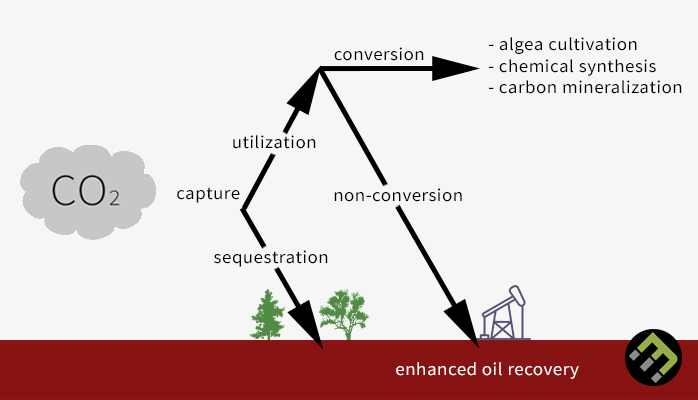Carbon Capture and Utilization (CCU)

Carbon capture and utilization, or CCU, is the process of capturing carbon dioxide (CO2) to be used later for a specific use. This process can be a key player in reducing climate change issues since it can positively impact the total levels of greenhouse gases. CCU aims for the further use of CO2 in the creation of more economically appealing products while maintaining the overall carbon neutrality of the production process.
CO2 accounts for around 77% of greenhouse gases. Industries across the world still rely heavily on the burning of fossil fuels in order to create energy. Other major contributors to CO2 emissions are transportation and the construction industry. Building materials like concrete and steel require massive amounts of energy in order to be produced. On the flip side, active deforestation of forests is removing natural and effective CO2 sinks which inadvertently adds to the total emissions.
Introducing CCU Applications
CCU technology is able to capture CO2 emissions from stationary sources like factories and manufacturing plants. Unfortunately, mobile sources like vehicles cannot be harvested for their carbon emissions. Several new and old technologies can be used to capture CO2 emissions from stationary sources, and the field is continuously developing new methods.
CO2 can be used for many applications, which is the utilization aspect of CCU. These applications create products that are economically viable, making them an appealing prospect for manufacturers.
Algae Cultivation
Microalgae is being considered as a serious source of renewable energy while also working as a CO2 sink. Microalgae feed on a diet of carbon dioxide, which can be sourced via CCU. The biofuel roughly uses 1.8 tonnes of carbon for every metric tonne of dry algae produced. However, since microalgae is a biofuel, its usage eventually leads to the release of carbon. The good news is that this amount is lesser than the input required for the growth of the algae. While this technology is still at a nascent stage, the possibilities of microalgae and its ability to trap CO2 are many.
Chemical Synthesis
CO2 can be converted to many other products via chemical reactions. This process of using CO2 in chemical reactions to create other useful products is known as a chemical feedstock. Some of the products produced using this methodology are polycarbonates and other organic compounds like urea and acetic acid. Novomer, a chemical company, uses CCU to create and produce a diverse set of plastic products. The company has received funding from the DOE and NSF in order to make this process commercial.
Carbon Mineralisation
Carbonates are formed when carbon dioxide is made to react with minerals like magnesium oxide and calcium oxide. These carbonates can then be used in the construction industry. A company named Calera created a mineralization process, which also produces water as a by-product. The biggest hurdle Calera and other companies who are focusing on carbon mineralization is a significant push back from the construction industry.
Enhanced Oil Recovery (EOR)
This method is used to extract oil from oil fields that cannot be extracted by other methods. There are several different methods when it comes to EOR. The use of CO2 is particularly effective in reservoirs or fields that are deeper than 2000 feet. The liquid or gas CO2 is used in a high-pressure form, where it mixes with the oil and causes it to swell and rise.
Final words
CO2 can be used as a base for creating commercially viable products. Not only does it help us reach global sustainability goals, but it also creates significantly important new verticals in the market.
However, in order to fight the impacts of climate change, we have to remain focussed on rebuilding business practices from the ground up. Shifting the narrative to ecologically conscious practices needs to be the norm with governmental agencies and policies enforcing and incentivising sustainable goals and practices.
Companies like EcoMatcher strive to work with businesses to encourage incorporating tree planting into their businesses, at the end creating the required carbon sinks we so desperately need.

